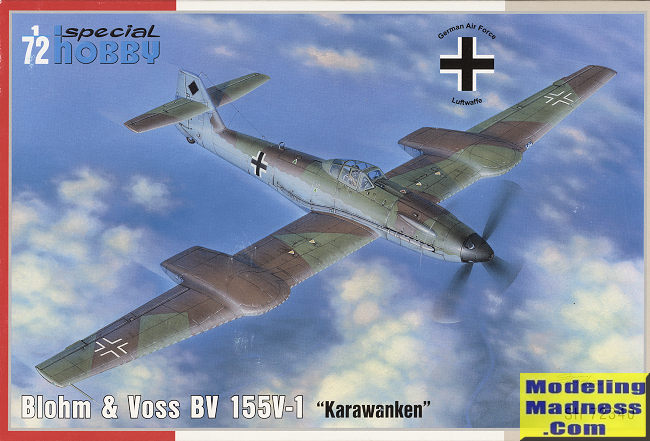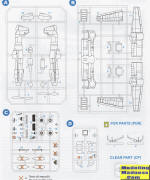
Special Hobby 1/72 BV-155v1
| KIT #: | SH 72340 |
| PRICE: | $7.50 on deep sale |
| DECALS: | One option |
| REVIEWER: | Scott Van Aken |
| NOTES: |
|

| HISTORY |
Performance estimates of the American B-29 Superfortress reached German command in early 1942. The bomber would cruise at an altitude at which no current German plane could operate effectively. To intercept it, the Luftwaffe would urgently need new aircraft. Work on such a high altitude fighter was begun by Messerschmitt, but in 1943 the project was passed to Blohm & Voss. The result would be the Bv155 prototype that made its first test flight in September 1944.
In September 1943, an order for five prototypes was placed. Blohm & Voss accepted the order only on condition they had complete design freedom and were not bound by Messerschmitt's work to date. The redesign was named the BV 155. B&V gave it a new laminar flow wing and tail unit, landing gear from the Ju 87 and many other parts of the plane. Further wind tunnel testing showed that there was a serious problem with the overwing radiators, at high angles of attack the wing "blanked" them from the airflow and cooling would suffer. Work moved to a revised B model.
The first prototype, BV 155 V1, took off for its maiden flight on September 1, 1944. Tests with the V1 showed that the outboard radiators provided inadequate cooling, especially at high angle of attack. The intakes on the next prototype were enlarged and underslung beneath the wing rather than placed over it. However, the enlarged radiators changed the aircraft's center of gravity which required moving the pressurized cockpit forward. The Blohm & Voss team took this opportunity to replace the original Bf 109G canopy with an aft-sliding all-round vision canopy, and the rear fuselage decking was cut down. This in turn required that a larger rudder be fitted. The ventral radiator bath was also enlarged.
With these changes, the BV 155 V2 flew on February 8, 1945. Blohm & Voss was still not satisfied with the design, and before the V2 began its flight trials they proposed that the engine be switched to the DB 603U having the larger mechanically driven supercharger of the DB 603E. The DB 603U promised a power of 1,238 kW (1,660 hp) for takeoff and 1,066 kW (1,430 hp) at 14,935 m (49,000 ft). The ventral turbosupercharger was retained. The Technische Amt decided to accept this proposal, and abandoned all work on the BV 155B in favor of the revised design, which was designated BV 155C.
The BV 155 V2 was damaged beyond repair during a bad landing. It was to be replaced in the test program by the BV 155 V3. The BV 155 V3 differed from the V2 in having the DB 603U intended for the BV 155C. However, the engine cowling and turbosupercharger were unchanged.
Various armament schemes for the BV 155B were proposed. One proposal had an engine-mounted (or Motorkanone) 30 mm (1.18 in) MK 108 cannon and two 20 mm MG 151/20 cannons. Another had a Motorkanone-mount 30 mm (1.18 in) MK 103 cannon and two wing-mounted 20 mm MG 151 cannons. Estimated maximum speed was 650 km/h (400 mph) at 12,000 m (39,370 ft) and 690 km/h (430 mph) at 15,999 m (52,490 ft). Service ceiling was to be 16,950 m (55,610 ft). Empty weight was 4,869 kg (10,734 lb). Normal loaded weight ranged from 5,126-5,488 kg (11,300-12,100 lb), depending on the armament provided.
According to some sources, V1 and V2 were both provided to the RAF after the war. V1 was flight tested until it was written off. The fate of V2 is not known. V3 is in storage at the US Air And Space Museum's storage facility.
| THE KIT |
 One
of the first vacuform kits I e
One
of the first vacuform kits I e ver
built was the Wings 72 BV-155. It was a very basic vac and I used a P-61 prop
and made the gear from aluminum tubing/rod. Still have it. I have always had a
fascination with this aircraft and when I saw one on deep discount at a recent
show, I had to pick it up.
ver
built was the Wings 72 BV-155. It was a very basic vac and I used a P-61 prop
and made the gear from aluminum tubing/rod. Still have it. I have always had a
fascination with this aircraft and when I saw one on deep discount at a recent
show, I had to pick it up.
This one is molded like every other recent Special Hobby kit in that it has great surface detail with large ejector towers on the inside of all the large parts such as the wings and fuselage. There is an injected single piece canopy/windscreen and two resin pieces that are used for much of the main gear wells.
This is a fairly basic kit. The cockpit is a floor and back section onto which one glues a seat, side consoles, control stick and rudder pedals. The instrument panel fits under an upper forward fuselage section. The fuselage radiator section is also built at this time then both are attached to one fuselage half. The tail gear/wheel piece is attached to one half and the fuselage halves are joined. All the exhaust detail is molded into the fuselage halves.
Wings are five pieces with a lower center section, full half upper section and partial lower wing sections. The two resin pieces for the gear well are attached during this process. Each side of the wing has a four piece lower wing radiator assembly. These appear to be handed. The radiator exhaust is molded closed. Once the wing, small upper fuselage section and the tailplanes are joined to the fuselage, then one builds up the main gear. These have the most parts of any construction step due to the doors and two half wheels. One of the gear doors needs to be bent when installed. There is a diagram to show the proper positioning of all the parts.
 Last steps
are to add some nose scoops, the prop assembly and the canopy. To pose the
canopy open it must be cut. Instructions are very well done with Gunze color
information. The lone marking option is in an upper splinter pattern of RLM
81/82 over RLM 76. Decals are nicely done with the usual multiple piece
swastika.
Last steps
are to add some nose scoops, the prop assembly and the canopy. To pose the
canopy open it must be cut. Instructions are very well done with Gunze color
information. The lone marking option is in an upper splinter pattern of RLM
81/82 over RLM 76. Decals are nicely done with the usual multiple piece
swastika.
| CONCLUSIONS |
Perhaps not for everyone, but this is a prototype that did fly and will make a great addition to anyone's collection. It has a really long wingspan for its size so will take up a goodly amount of shelf space. An ea
| REFERENCES |
https://en.wikipedia.org/wiki/Blohm_%26_Voss_BV_155
If you would like your product reviewed fairly and fairly quickly, please contact the editor or see other details in the Note to Contributors.
Back to the Main Page Back to the Review Index Page Back to the Previews Index Page